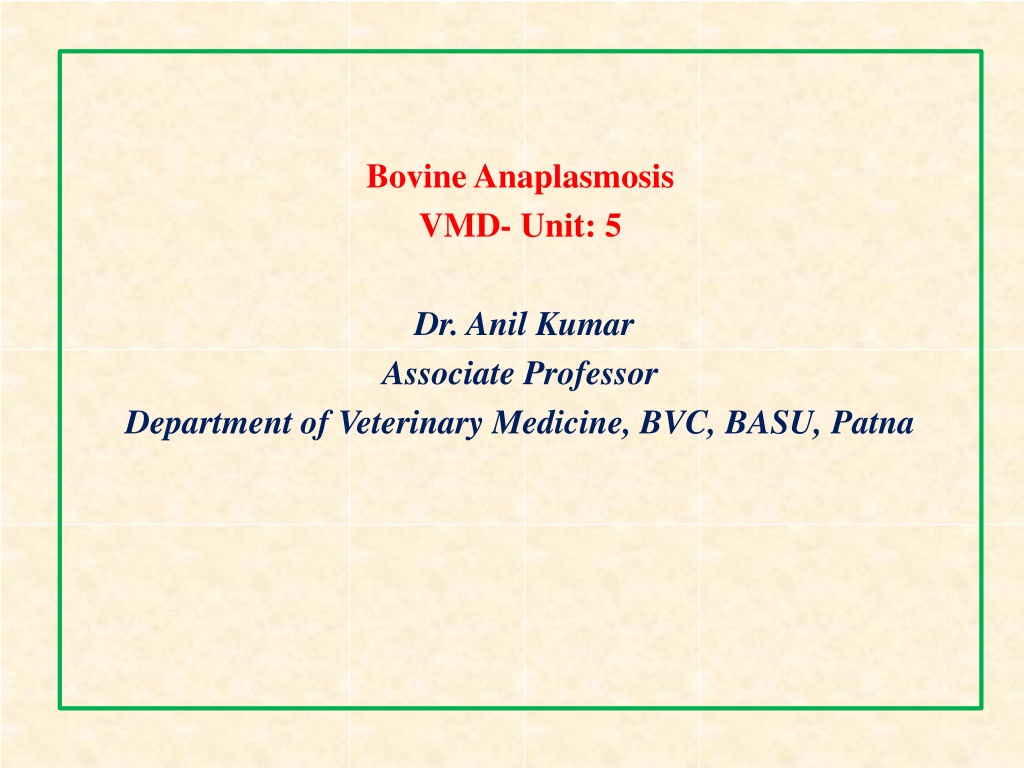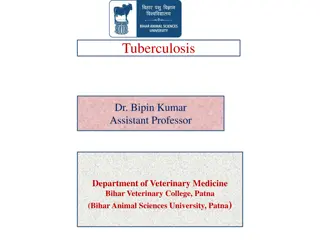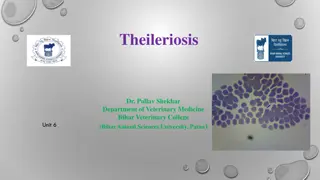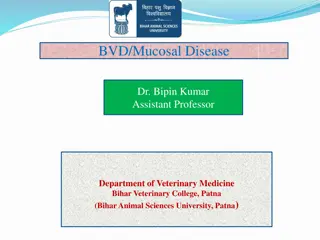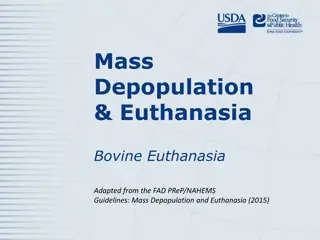Understanding Bovine Anaplasmosis: Causes, Symptoms, and Management
Bovine anaplasmosis is an infectious disease in ruminants caused by Anaplasma species transmitted by ticks. This article covers the etiology, host susceptibility, transmission methods, symptoms, and life cycle of the disease. It highlights the age-related susceptibility in cattle and provides insights into the clinical phases and manifestations of the illness. Understanding these aspects is crucial for effective management and prevention of bovine anaplasmosis.
Download Presentation

Please find below an Image/Link to download the presentation.
The content on the website is provided AS IS for your information and personal use only. It may not be sold, licensed, or shared on other websites without obtaining consent from the author. Download presentation by click this link. If you encounter any issues during the download, it is possible that the publisher has removed the file from their server.
E N D
Presentation Transcript
Bovine Anaplasmosis VMD- Unit: 5 Dr. Anil Kumar Associate Professor Department of Veterinary Medicine, BVC, BASU, Patna
Introduction Synonym: Gall sickness It is an infectious hemotropic (intra-erythrocytic)disease of ruminants caused by by several species of genus Anaplasma. Etiology and Host affected: Etiological agent Anaplasma bovis Vector Haemaphysalissp.Rhipiceph alus sp., Amblyomma sp. Dermacentor sp. Infected host Ruminants Infected Cell Monocytes Anaplasma ovis Small ruminants (goats, sheep Ruminants Ruminants RBCs Anaplasma marginale Ixodes sp./Dermacentor sp. Anaplasma centrale Ixodes sp.Haemaphysalis sp RBCs RBCs Anaplasma phagocytophi lum (HGAagent) Ixodes sp.Dermacentor sp. Small ruminants forming and humans, wild, horses, dogs Dogs Granulocyte Anaplasma platys Rhipicephalus sanguineus Platelets (Canine cyclic thrombocyto penia)
About 20 species of ticks have been incriminated as vectors worldwide, but the disease is principally transmitted biologically through tick bites (Ixodes ticks, mainly Boophilus microplus). Host Affected: Cattle are the major hosts but infections also occur in zebra, water buffalo, bison, sheep, goats, deer, antelope, giraffes and camel Bos indicus type cattle are less susceptible because of their greater resistance to tick infection than Bos taurus and their cross bred Anaplasmosis infection is higher in female than male animals due to hormonal disturbances, milk production, draught power and breeding system which pose it to weakened immune system
Age-related host susceptibility: Under 6 months of age, the illness is rare Cattle more than 2 years of age are most likely to have severe, acute and potentially fatal disease Method of Transmissions: Transstadial transmission Biological pathway through mostly ticks Mechanical pathway (biting insects or fomites contaminated with blood/by blood contaminated equipment) The organism can be transmitted from cow to calf transplacentally during gestation, particularly during the second or third trimester of pregnancy
SYMPTOMS: Severity of the disease depends on various factors such as virulence of the strain, age-related host susceptibility and breed resistance. Bovine anaplasmosis has different forms of clinical phases including; Per-acute, acute, chronic and mild. In per-acute form: The disease the death occurs within hours of the onset of clinical signs due to icterus. On careful examination weakness may be the first clinical sign. Acute form: In the early stages, animals become lethargic, anorexic, have decreased milk production, and develop fever. There are pale or icteric mucous membranes and the cows with light skin initially looked pale around the eyes and muzzle, but later this can change to a yellowish color (jaundice). Other signs include depressed rumination, constipation with dark brown mucous-covered feces, dry muzzle, and weight loss.
Infected cattle subsequently develop varying degrees of anemia, which can be fatal if untreated. Cattle having the signs of anaplasmosis should be handled with caution because of cerebral anoxia can cause aggressiveness. Severe anemia coupled with stress may precipitate sudden death and abortions may occur due to fetal anoxia. If animals survive the initial infection, they generally become carriers Chronic form: The signs may follow an acute infection with gradual emaciation Mild form: Mainly present in cattle infected under one year old Signs are usually few with a mild pyrexia
Diagnosis: History Clinical signs Microscopic Serological tests Complement agglutination test (CAT) Indirect fluorescent antibody (IFA) test Enzyme linked immunosorbent assays (ELISA) such as a cELISA, indirect ELISA and dot ELISA The two serological tests currently preferred for identifying infected animals are the cELISAand the CAT Molecular Test Nucleic-acid-based tests such as polymerase chain reaction (PCR) Targeting at the Anaplasma msp4 and/or msp1 genes, msp5 and 16S rRNA genes fixation (CF) test, Capillary agglutination assay, Card
Treatment: Tetracycline (tetracycline, chlortetracycline, oxytetracycline, rolitetracycline, doxycycline, minocycline)) is an excellent antibiotic Oxytetracycline @2 0 mg/kg IV q24h for 5 days Imidocarb is also highly efficacious against A. marginale as a single injection (as the dihydrochloride salt at 1.5 mg/kg, SC, or as imidocarb dipropionate at 3 mg/kg) Whole blood transfusions also may be necessary when anemia is judged to be life-threatening in acutely infected cattle. Supportive therapy which includes, oral liver tonic, multivitamin syrup and or Injectable liver extract with B-complex may be recommended.
PREVENTIONAND CONTROL: Currently the available control measures for tick-borne diseases are the use of acaricides for reduction or tick populations, specific chemotherapy, chemoprophylaxis, controlled exposure and vaccination. However, the control measures for bovine anaplasmosis vary with geographical location which include: Maintenance ofAnaplasma free herds Vector control Prevention of iatrogenic transmission Administration of antibiotics and Vaccination.
